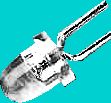Clusters or arrays of these devices can be used as "cold light" illuminators for microscopy and instrumental insemination.

Single devices are adequate for II if they are close to the anaesthetised queen. A cluster of three will provide a wider field of illumination.
A cluster of seven would appear to provide more light than is really required for Insemination purposes, but may well be OK at low magnifications for use with a compound microscope. High magnification compound microscopy may need clusters of nineteen or more. At first sight this may appear costly, but if compared to the available fibre optic illuminators it looks to be a good deal.
Whilst these devices do not emit heat along with the visible radiation they do get hot if over driven. I will have to investigate this by building a prototype cluster of seven and making some measurements. If this heat is noticeable, the devices could be mounted in an aluminium block with fins and drilled holes for fan cooling, but this is a bridge that can be crossed when and if required.
The use of ultra bright coloured LEDs in arrays that contain more than one colour of emission, in conjunction with variable duty cycles, gives a very wide range of possible illuminating colours, that may have extra un-envisaged uses in compound microscopy.
Maximum intensity is realised by pulsing the device into the overdriven range... A 555 driving an emitter follower should be adequate, but watch out for RF interference from the 555.
Generalised Specifications... for bright LEDs taken from multiple sources.
| Typical Values | Forward Voltage VF (Volts) |
Reverse Current IR (µA) |
Optical Power Output PO (mW) |
Brightness (candela) | Power Dissipation (mW) | |
|---|---|---|---|---|---|---|
| Characteristics (@ 25°C) | ||||||
| Color | Min. | Max. | Typ. | Typ. | Max. | Typ. |
| Bright Red | 1.7 | 2.0 | ? | ? | 0.6 | 40 |
| Ultra Bright Red | 1.7 | 1.9 | ? | 1.2-1.8 | 50 | |
| Blue | 3.6 | 4.0 | 50.0 | 6.0 | 3.0 | ? |
| Green | 3.5 | 4.0 | 50.0 | 4.0 | 10.0 | ? |
| Bright Yellow | 2.0 | 2.3 | 2.3? | 105 | ||
| White | 3.6 | 4.0 | 50.0 | 4.0 | 5.6 | ? |
| Electrical Conditions | IF=20mA | VRev=5V | IF=20mA | |||
| Absolute Maximum Ratings (Ta=25°C) | Forward Current (mA) |
Pulsed Forward Current (mA) |
Reverse Voltage (V) |
Power Dissipation (mW) |
Operating Temperature (°C) |
Storage Temperature (°C) |
|---|---|---|---|---|---|---|
| Blue | IF=30 | IFP=100 | VR=5 | PD=120 | Topr -30 to +85 |
Tstg -40 to +100 |
| Green | ||||||
| White |
|
Colour temperature - White... 8000° Kelvin Wavelength of Blue... 470 nanometre Wavelength of Green... 525 nanometre |
Wavelength of RED... 645-700 nanometre Pulse Width... 10ms, Duty cycle... 1:10 |
|---|